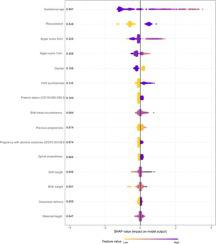Journal of Biomedical informatics ( IF 4.0 ) Pub Date : 2020-12-05 , DOI: 10.1016/j.jbi.2020.103651 Kim S Betts 1 , Steve Kisely 2 , Rosa Alati 1

|
Objectives
A major challenge for hospitals and clinicians is the early identification of neonates at risk of developing adverse conditions. We develop a model based on routinely collected administrative data, which accurately predicts two common disorders among early term and preterm (<39 weeks) neonates prior to discharge.
Study design.
The data included all inpatient live births born prior to 39 weeks (n = 154,755) occurring in the Australian state of Queensland between January 2009 and December 2015. Predictor variables included all maternal data captured in administrative records from the beginning of gestation up to, and including, the delivery, as well as neonatal data recorded at the delivery. Gradient boosted trees were used to predict neonatal respiratory distress syndrome and hypoglycaemia prior to discharge, with model performance benchmarked against a logistic regression models.
Results
The gradient boosted trees model achieved very high discrimination for respiratory distress syndrome [AUC = 0.923, 95% CI (0.917, 0.928)] and good discrimination for hypoglycaemia [AUC = 0.832, 95% CI (0.827, 0.837)] in the validation data, as well as outperforming the logistic regression models.
Conclusion
Our study suggests that routinely collected health data have the potential to play an important role in assisting clinicians to identify neonates at risk of developing selected disorders shortly after birth. Despite achieving high levels of discrimination, many issues remain before such models can be implemented in practice, which we discuss in relation to our findings.
中文翻译:

出院前预测新生儿呼吸窘迫综合征和低血糖:利用卫生管理数据和机器学习
目标
医院和临床医生面临的主要挑战是及早发现具有发展为不利条件的风险的新生儿。我们基于常规收集的管理数据开发了一个模型,该模型可以准确预测出院前的早产和早产(<39周)新生儿中的两种常见疾病。
学习规划。
数据包括2009年1月至2015年12月在澳大利亚昆士兰州发生的39周之前出生的所有住院活产婴儿(n = 154,755)。预测变量包括从妊娠开始到出生的行政记录中捕获的所有产妇数据,以及包括分娩以及分娩时记录的新生儿数据。使用梯度增强树在出院前预测新生儿呼吸窘迫综合征和低血糖,模型性能以逻辑回归模型为基准。
结果
在验证数据中,梯度增强树模型对呼吸窘迫综合征[AUC = 0.923,95%CI(0.917,0.928)]的分辨力非常高,对低血糖症的鉴别能力很好[AUC = 0.832,95%CI(0.827,0.837)] ,并且优于逻辑回归模型。
结论
我们的研究表明,常规收集的健康数据可能在协助临床医生识别出生后不久有发展为特定疾病风险的新生儿中发挥重要作用。尽管歧视程度很高,但在实践中实施此类模型之前仍然存在许多问题,我们将结合研究结果进行讨论。











































 京公网安备 11010802027423号
京公网安备 11010802027423号